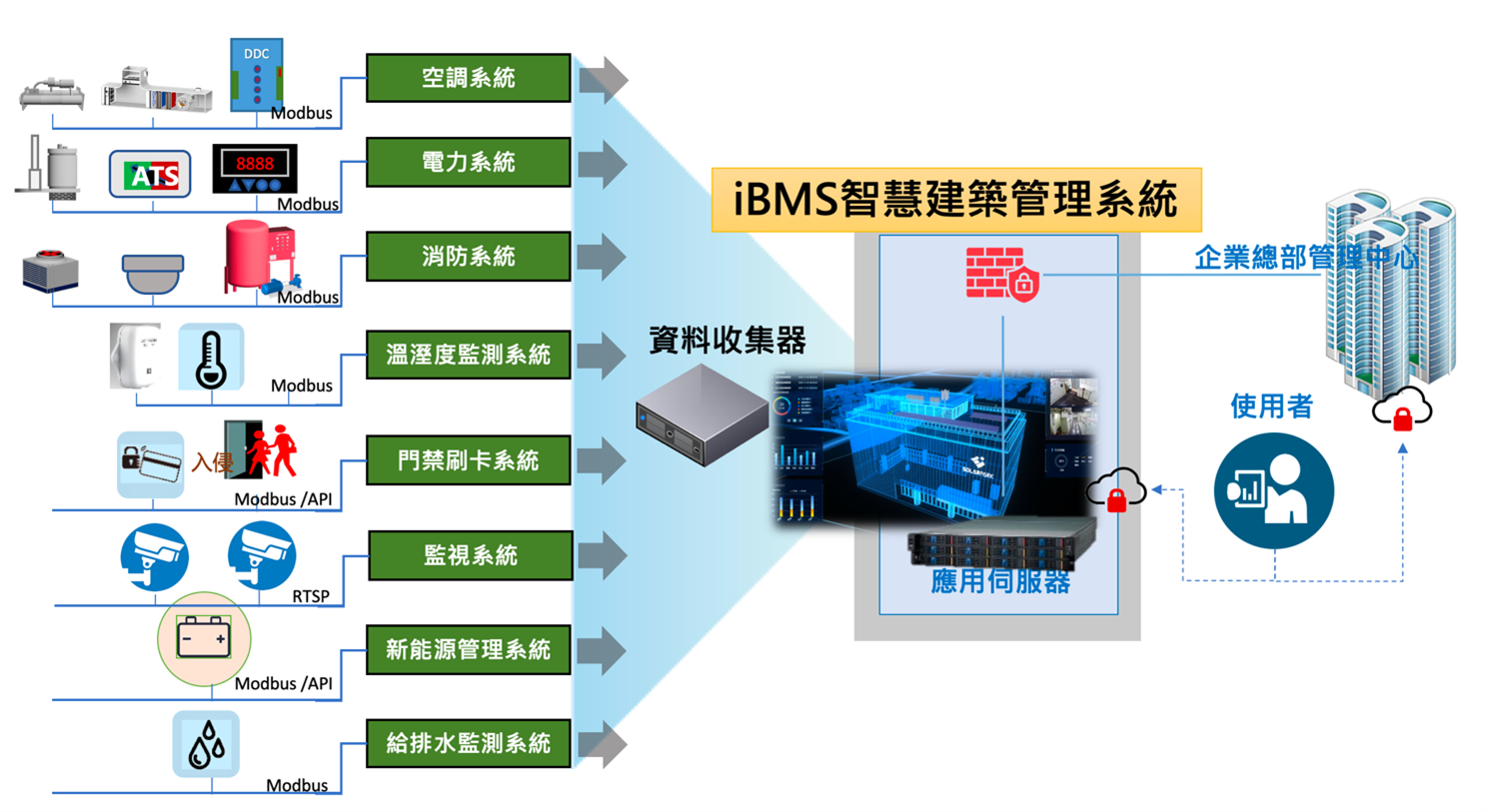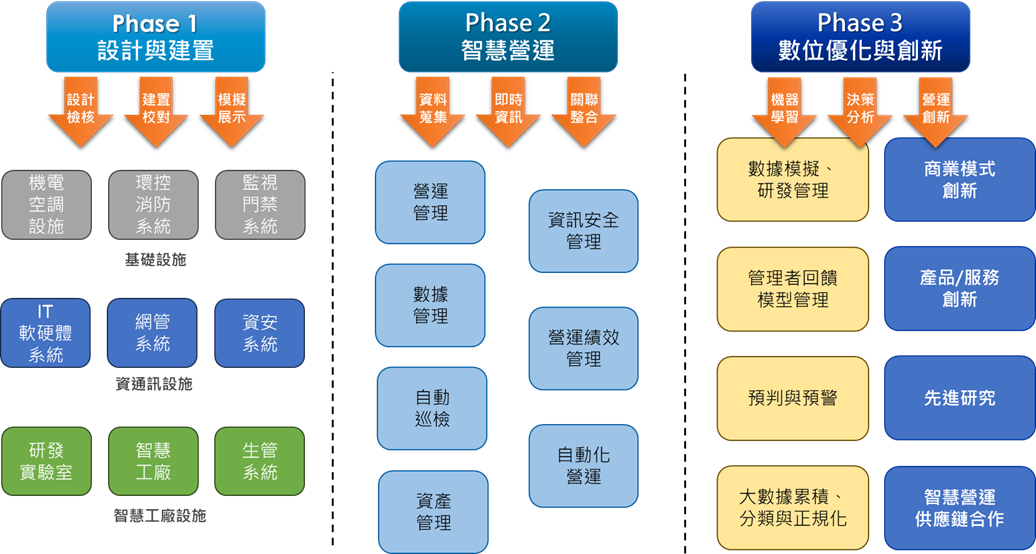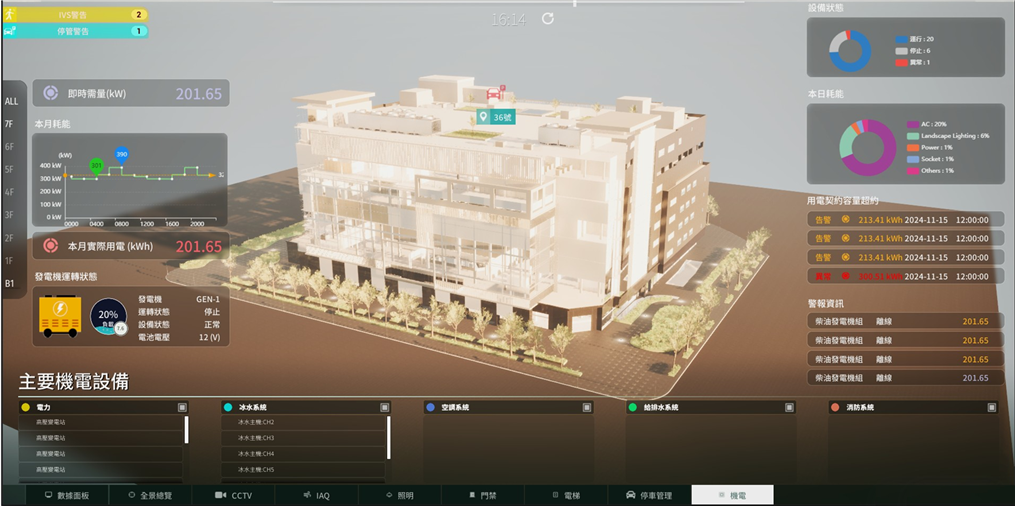Smart Applications
Intelligent Transportation Service | Smart City Control Solutions | AIoT innovative application services assist digital transformation | Smart Pole Solution | AR remote video collaboration application | Drone application solutions - unmanned aerial vehicles / drones | VSV Cloud (Video Surveillance Cloud) | Technological disaster prevention and smart construction solutions | Intelligent Building Management System solutions
Intelligent Building Management System solutions
Brief Introduction
The Intelligent Building Management System (iBMS) utilize the completed Building Information Modeling (BIM) as operation platform achieve 3D Web-based Visual facility Management. Through the Internet of Things (IoT), Artificial Intelligence (AI), Building Information Modelling (BIM), Intelligent Surveillance (IVS), Intelligent Building Management System (iBMS), the intelligent integration platform developed with Open Framework can integrate the five major mechanical and electrical systems, including electrical, HVAC, fire protection, water supply and drainage, and weak current facilities, to meet the needs of healthy, comfortable, safe and energy-saving intelligent buildings, and can also integrate the production process management of the factory.
With smart facility unified management capabilities and comprehensive oversight, the system demonstrates Digital Twin effects by combining 3D models with IoT and real-time machine running data and historical information. Additionally, building operator can perform monitoring and maintenance facility tasks through specialized facility management (FM) system.
Descriptions of Features and Advantages
The iBMS implements 3D visualization by importing lightweight original BIM models, completely preserving all static parameter information while integrating real-time equipment running data and operational status. This achieves smart maintenance and security monitoring demand.
Furthermore, according to the UN Global Status Report for Buildings and Construction, buildings aggregate 35-38% of global carbon emissions. In order to meet the 2050 net-zero carbon goal, how to reduce the building energy consumption must be addressed.
Therefore, the iBMS system can support building owners in managing equipment assets and the operational energy consumption of various facilities, enabling efficient carbon asset management and assisting owners in advancing their ESG sustainability initiatives.

iBMS System Architecture
Benefits
The iBMS (Intelligent Building Management System) serves as the top-level function of the overall smart building system. It cross-functionally collects both static and dynamic information related to building equipment operation, running data, monitoring information, and operational processes.
The iBMS System adopts a digital twin operational model to assist asset owner in obtaining prestigious Smart Building and Green Building certifications. This support contributes to achieving sustainability development goals. Key benefits of implementing iBMS include:
Achieving Sustainable Development Goals
- Supporting 2050 net-zero emissions target
- Complying with international building energy standards
- Achieving ESG sustainability goals
Enhancing Operational Efficiency
- Facility operation automation
- Maintenance cost optimization
- Human resource optimization
- Extended equipment lifecycle
Optimizing Building Energy Consumption
- Improved energy usage efficiency
- Real-time abnormal consumption detection
- Smart energy-saving strategy execution
- Significant energy cost reduction
Optimizing Property Management
- Data visualization
- Real-time operational status monitoring
- Complete operational record keeping
Applications
The implementation of Building Information Modeling (BIM) for full building lifecycle management has become a mature and widely adopted market trend, both domestically and internationally. This applies to public works, traditional and high-tech factories, office buildings, shopping centers, smart residential communities, and general construction projects.
Service Process
The iBMS solution is recommended to be implemented in three phases: Design and Construction, Smart Operations, and Digital Optimization and Innovation. As the enterprise continues to develop, the scope and maturity of intelligent applications will gradually expand and improve over time.

Tools
The iBMS integrates critical IoT information from various mechanical, electrical, and facility systems into a smart data platform, using standardized formats for smart building operation and management. It consolidates and visualizes spatial positioning and location data of monitoring systems and devices within the building, such as MEP systems, fire protection, security, surveillance cameras, and access control through 3D BIM visual graphics. This enables comprehensive analysis, application, and presentation, achieving the synergistic benefits of ICT-integrated smart building management.
Provision method
The “Smart Building Evaluation Manual 2024 Version” by the Architecture Research Institute, Ministry of the Interior, effective from December 1, 2024, serves as the evaluation criteria for Smart Building Label or Candidate Smart Building Certificate applications. HwaCom can plan suitable solutions based on clients’ desired smart building certification levels and indicator scores to help them successfully obtain Smart Building certification.
This solution is particularly suitable for organizations undergoing digital transformation, pursuing sustainable development, and seeking to improve operational efficiency. Through high system integration and flexibility, it provides customized services for different venues, creating healthy, comfortable, and safe smart building environments while achieving energy-saving and carbon reduction sustainability goals.
iBMS Applicable Venues:
Commercial Buildings
- Office buildings
- Shopping centers
- Hotels and malls
Public Buildings
- Smart parks
- Social housing
- Medical facilities
Industrial Facilities
- Data centers
- High-tech plants
- Smart factories
Special Application Areas
- Telecom equipment rooms
- Smart factory management
- Large-scale industry park management
Contact Window
Reference Data

iBMS Dashboard Sample

